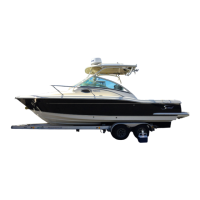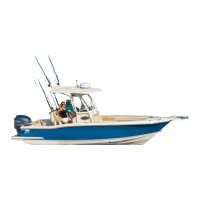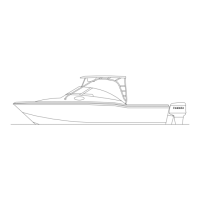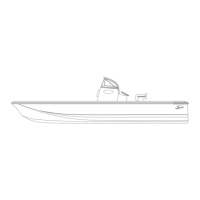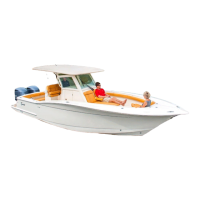Do you have a question about the Scout Boats 262 Abaco and is the answer not in the manual?
Explains DANGER, WARNING, CAUTION, NOTICE statements and offers important operating notes.
Provides overarching safety advice for boat operation and fuel handling.
Section for recording boat, engine, and dealer details for service reference.
Details manufacturer, hull ID, design category, and capacities.
Covers stem-to-stern and hull warranty, exclusions, and transfer procedures.
Procedures for registering warranties and obtaining service.
Details on Yamaha outboard motor warranty coverage and necessary steps.
Introduces outboard motor types, maintenance, and safety.
Discusses marine growth, galvanic corrosion, and protective anodes.
Details lubrication requirements and raw water cooling system operation.
Explains propeller types, sizing, and their impact on boat performance.
Describes gauges for monitoring engine RPM, temperature, and oil levels.
Introduces throttle, shift, steering, and trim tab controls.
Explains engine controls, neutral safety switch, and operation.
Details tilt/trim operation and the engine emergency stop switch.
Describes the hydraulic steering and trim tab functionality.
Covers maintenance for steering, trim tabs, and general controls.
Covers compliance, safety, and general fuel system components.
Details the fuel tank, withdrawal tubes, and fuel filters.
Step-by-step guide for safe refueling and handling fuel.
Maintenance for fuel lines, filters, and tank, including fuel age considerations.
Introduces 12V DC and 120V AC systems, batteries, and wiring.
Explains battery setup, switches, circuit breakers, and accessory distribution.
Covers AC panel, shore power connection, and electrical safety.
Details the bonding system for corrosion protection and galvanic isolators.
Maintenance procedures for both DC and AC electrical systems.
Table for managing AC accessory loads and preventing circuit overload.
Describes the potable water tank, pump, and distribution network.
Instructions for filling, priming, and operating the water system.
Operation of the shower and drainage via the sump pump system.
Covers routine cleaning, sanitizing, and winterizing.
Introduces raw water pumps, thru-hull fittings, and system priming.
Instructions on how to use the cockpit washdown system.
Details on filling, draining, and maintaining the livewell.
Operation and maintenance of the AC unit's raw water cooling.
Routine checks and cleaning for raw water system components.
Explains gravity drainage via thru-hull fittings and system checks.
Describes scupper drains and gutter systems for cockpit water removal.
Details bilge pump operation, float switches, and garboard drain.
Drainage for fishboxes, livewells, showers, and cabin sinks.
Maintenance for rope locker drains and overall system upkeep.
Discusses cabin ventilation via deck hatch and port windows.
Emphasizes ventilation to prevent CO buildup and detector use.
Routine upkeep for hatches, doors, and CO detector testing.
Covers rails, cleats, anchor locker, and deck fittings.
Discusses engine mounting, swim platform, and boarding ladder.
Details cockpit hatches, stern bilge access, and tackle storage.
Describes the head compartment, sink, shower, and storage areas.
Explains manual/electric toilet use, waste discharge, and holding tank.
Covers cabin lighting, galley, sink, V-berth, and aft berth.
Operation of AC unit and care for interior teak woodwork.
Introduces safety equipment required by Coast Guard and manufacturers.
Details engine alarms, neutral safety, and stop switches.
Lists mandatory gear like PFDs, distress signals, and fire extinguishers.
Explains CO detector function, hazards, and importance of ventilation.
Covers first aid preparedness and optional safety equipment like EPIRBs.
Identifies critical warning labels and their meanings for safe operation.
Covers pre-cruise checks, safety compliance, and responsible operation.
Basic navigation rules for vessel interaction and signaling.
Comprehensive checklist before starting engines and operating the boat.
Guidance on starting engines, checks, and engine break-in procedures.
Techniques for maneuvering, docking, anchoring, and mooring securely.
Steps for handling propulsion failure, collisions, grounding, and capsizing.
Procedures for man overboard recovery and proper waste management.
Guidance on selecting, loading, securing, and towing the boat trailer.
Covers hull cleaning, bottom painting, anodes, and gel coat care.
Maintenance for vinyl upholstery, canvas tops, and clear curtains.
Care for cabin interior, woodwork, and Corian surfaces.
Keeping the bilge clean, maintaining pumps, and cleaning drains.
Preparing the boat for storage, including fuel, systems, and lifting.
Detailed steps for winterizing freshwater, raw water, heads, and engines.
Steps to prepare the boat for use after storage or winter lay-up.
Shows the primary electrical harness connections.
Illustrates the battery select panel and its wiring details.
Visual representation of DC and AC electrical system layouts.
Diagrams of fuel, water, and drainage systems.
Illustrates the boat's hydraulic steering system configuration.
Provides definitions for common boating terms.
Chart detailing maintenance tasks by frequency.
Form for recording service history and repairs.
Official form for documenting boating accidents and incidents.
Guide and form for planning trips and notifying contacts ashore.
Solutions for steering, wandering, and starting issues.
Solutions for sluggishness, speed loss, and vibrations.
Solutions for common problems with engines, pumps, and AC.
| Deadrise | 20° |
|---|---|
| Length Overall (LOA) | 26 ft 2 in |
| Fuel Capacity | 150 gal |
| Water Capacity | 20 gal |
| Max Horsepower | 400 hp |
| Passenger Capacity | 12 |
| Beam | 9 ft 0 in (2.74 m) |
